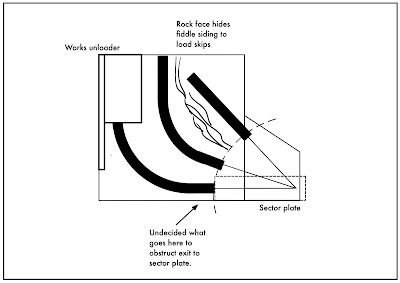The German film director Fritz Lang once said. "To begin with I should say that I am a visual person. I experience with my eyes and never, or only rarely with my ears - to my constant regret."
My world of designing micro layouts is very much similar. It's a visual thing. I experience it only with my eyes, Rarely with any logic. I think in images, scenes, cameos, as perhaps James Hilton would call them and fit them into a layout. James' website is full of sketches of great schemes for model railways. I excitedly wait for his book on layout design to arrive from the UK.
Chris Mears, another model railroader whose blog I read regularly, writes at length about the visual aspect of layout design and the importance of working on paper.
So when I cobbled together this scene that has kickstarted progress on my Christmas Challenge Micro I had to see how I could fit a layout around it.
 |
| What's it going to be? |
How does this scene fit in? This is where problems begin. Saner people than I will have a more logical flow to layout design. They’ll say they’re going to design a small peat works layout for example. Some aspects of the layout are taken care of in that statement. What the structures can look like and how trains operate are dictated by the industry.
Me? I’ve come up with a scene and a track plan independent of each other and now need to make them fit into a layout concept. It’s “arse about face” as some would say.
It’s these times when the sketches are so important for me, as I try to visualise a locale, a site for the scheme, and a rationale for the project.
Sometimes ideas come so thick and fast it can be difficult to get them down.
Is that a rock face? Or a retaining wall? Should the awning cover the unloading point, or should I make it a lean to engine shed? These ideas zip through my brain faster than I can draw (or even type in this post) Sketches become light, ephemeral scratches on the paper. The idea may have gone before I can fully visualise it. But the feeling about the idea remains because I have the scratches on paper.
I have to slow down and ask myself questions.
What material would be transported in skip wagons to be processed into something or other?
 |
| Ephemeral scratches |
Clay perhaps, that would be a first thought. Though if this was to be a brick or tile works, a slope to winch wagons up to the top level of a Pug Mill would be in order on the layout. Though my old pre-Purespring Watercress layout, Cuplars fine tile and Ceramics didn’t have one.
 |
| Those scratches are Marram Grass. Really. |
Then there’s this sketch. I’m just trying to establish what I might do to cover the exit to the sector plate. I scratched some long grass onto the top of the “hill” that covers the hidden siding. “That looks like Marram Grass.” I thought. Wham! A whole concept hits me instantly
Salt.
The Lincolnshire (UK) coast has miles and miles of Salt marsh. Salt has been produced there since Roman times. Continued inundations from the sea had pretty much killed the industry off by the 1800’s though.
This micro layout scene could represent a small salt works that has survived into the 20th or even 21st century just behind the sand hills and sea defences. A loco shoves a couple of skips onto the layout. Appearing ostensibly, through a gated gap in the sea barrier to have the skips emptied at the structure. Then it shuffles off back to the saltern to collect more salt.
A fun idea that incorporates a lot of history from my home county just up the road from where I used to live.
But that photograph recycles the structures from my
Tribute to Cuddle project from a couple of years ago.
The original Cuddle, by the late Andy Anderson, was an exploration of the Shale oil industry on the south coast of England and the original layout was an idea based around operating a layout that was only a single length of track.
For my version of the layout I had built the main structure and awning that you see. A combination
stone and brick chimney that I’m quite proud of and a
shale oil condenser that boggles my mind when I think of the effort I put in to it. Then the project stalled. I put a lot of effort into all of the structures. It would be a shame not to use them.
Could I use the stone built structures for a small Lincolnshire saltworks? Maybe, maybe not. It’s unlikely that there would be any stone built structures on the Lincolnshire coast. There’s no stone for miles. Any structure hereabouts would probably be wood or brick depending on their permanence.
What would a small salt works even look like? Would a salt works have a chimney? Is heat needed in the process? Then there’s my gas condenser, I doubt there’s any need for one of those at a small salt works.
There you are. I’m not a lot further on deciding on a concept for the layout. It could be a salt works, it could be a shale oil gas plant.
This may not be the best way to design a layout. But at times, when the ideas flow, it’s quite exhilarating.




























